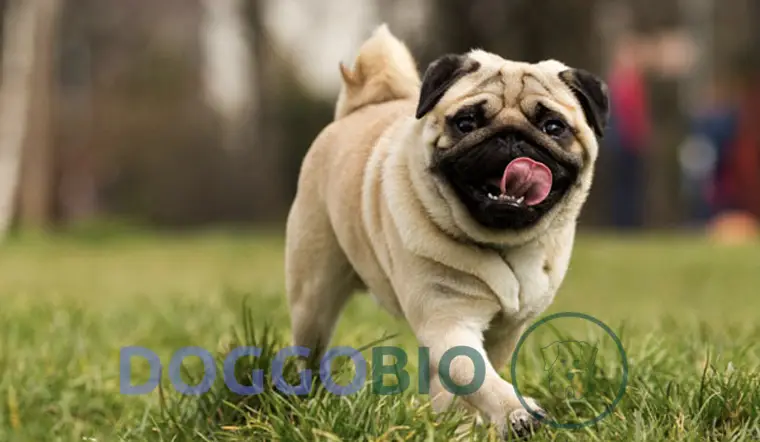Welcome to the delightful world of the “Pregnant Pug,” where adorable charm meets the joyous anticipation of new life. Within the cuddly confines of this endearing canine tale, we delve into the journey of a pug as she embraces motherhood, showcasing the resilience, tenderness, and undeniable love that defines this beloved breed.
Follow us on a heartwarming adventure exploring the wonders of pregnancy, the trials and triumphs of motherhood, and the unbreakable bonds between a pug and her devoted human companions. Prepare to be enchanted by the unmistakable charm of the “Pregnant Pug,” a story that celebrates the beauty of life, while also shedding light on the importance of dog health and the care needed during this miraculous time.
How Long is a Pug Pregnant?

Pugs will typically stay pregnant for about 58 to 68 days. On average, a Pug’s pregnancy lasts approximately 63 days, starting from the date of conception to the delivery date.
Signs of Pug Pregnancy
We understand the challenge of determining whether your Pug is pregnant. Fortunately, several early signs may indicate a Pug pregnancy. Here’s a list of these symptoms and early signs:
1. Behaviors and physical changes
A pregnant Pug’s behavior may shift from energetic and playful to sluggish and tiredness.
2. Increased appetite
A pregnant Pug might not eat as much as before and may even show disinterest in her meals.
3. Weight Gain & Swollen Belly
As each day passes, you’ll notice the Pug’s stomach gradually getting more significant. This enlargement usually becomes evident around two weeks or 14 days after insemination.
4. Fetal Movement:
Sometimes, the vet could feel movement in the Pug’s belly, often detectable as early as 15 to 30 days after insemination.
5. Increase in nipple size
The Pug’s chest may become red and enlarged as part of the preparation for nursing.
How To Tell If A Pug Is Pregnant?

If you wonder, “Is my Pug pregnant?” don’t worry; there are reliable ways to check and confirm her pregnancy. Let’s explore two methods that offer proof of your Pug’s pregnancy.
1. Ultrasounds
Ultrasounds are a vital tool in determining whether your Pug is pregnant. It’s best to schedule a vet visit for this purpose, ideally around 25 days after mating for the most accurate results. While the procedure itself is generally painless, it can cause some discomfort to your Pug, as their belly hair needs to be shaved off.
Keep in mind that ultrasounds can be pricey, ranging from $300 to $500. Alternatively, you can wait for more visible signs of pregnancy, but consulting with your vet will help you decide the best approach for your Pug’s health and well-being.”
2. Blood Sample
A blood test is a reliable way to confirm your Pug’s pregnancy, typically recommended around 35 days after mating for accurate results. Compared to ultrasounds, it’s generally more cost-effective.
However, timing is crucial. Conducting the test too early may lead to false negatives. Coordination with your vet is key to ensure the timing is right for an accurate outcome, allowing you to plan ahead for your Pug’s pregnancy journey.
Pregnant Pug Stages
If you suspect that your Pug may be pregnant and you ca unable to get a vet appointment right away, don’t worry; a dog’s pregnancy progresses rapidly compared to humans, so that signs will manifest quite early.
Here are the common signs and symptoms that indicate your Pug might be pregnant:
Week 1
During Week 1, you’ll typically observe no significant signs of pregnancy in your Pug. However, towards the end of this stage, a few dogs might experience mild nausea, resulting in a slight decrease in appetite.
Weeks 2 and 3
As your Pug enters Weeks 2 and 3, you’ll notice signs of pregnancy gradually appearing. Some of these changes might be subtle, making you wonder if they’re objective indications of pregnancy. Here are the common symptoms during this period:
- Increased tiredness compared to her usual energy levels.
- A slightly swollen stomach.
- More frequent self-grooming than usual.
- Enlarged nipples on her tummy.
During Week 2, your Pug may experience some morning sickness, resulting in occasional bouts of nausea. However, this is usually short-lived, and as she transitions into Week 3, you’ll notice her appetite becoming stronger and heartier.
Week 4
As Week 4 arrives, the signs of pregnancy become pretty evident in your Pug:
- Her stomach will be noticeably distended, indicating she is carrying a litter.
- Her nipples will enlarge and darken as her body prepares for nursing; some may protrude more than before, primarily if she has been bred back, as they fill with colostrum.
- Nesting instincts will kick in, and she’ll exhibit a strong desire to prepare for the impending birth.
- Her appetite will experience a significant increase. It’s common for pregnant dogs to consume up to twice as much food as usual during this stage.
Weeks 5 and 6
As Weeks 5 and 6 approach, your Pug will exhibit the following signs, indicating that she is nearing the end of gestation:
- She may tire out very quickly at this stage.
- The Pug will likely prefer staying home and might be less social than usual. It’s normal for her to seek a quiet spot to rest and relax.
- She will experience a final weight gain of approximately 10% of her average body weight during this period. The exact amount may vary based on the litter size. This weight increase comprises not only the importance of the developing pups (each weighing less than a pound, mere ounces) but also includes fluids (water and amniotic fluids) and tissue (amniotic sacs surrounding each fetus).
Caring for a Pug Pregnancy

1. Proper Nutrition
During weeks 3 or 4 of pregnancy, your Pug’s appetite will increase. Allow her to eat as much as she desires, focusing on nutritious and healthy meals and snacks. While she needs slightly more fat, ensure her diet remains wholesome. Consider adding fresh raw baby carrots or steamed potatoes. Expect her to eat 25 to 50% more than usual.
2. Supplements
There’s no need to provide additional vitamins and mineral supplements to your pregnant Pug; doing so can lead to health issues for both her and the developing fetuses.
Avoid giving her extra calcium, as it can increase the risk of dangerous conditions like eclampsia, seizures, high blood pressure, and joint abnormalities in the puppies.
3. Exercise and rest.
Unless the veterinarian advises otherwise, continue daily walks with your Pug at a moderate pace. Regular exercise helps keep her fit, and avoiding a sedentary lifestyle prevents sore joints and muscles.
Depending on the number of pups she’s carrying during the final two weeks of pregnancy, she may face difficulty maneuvering around, and walks can be put on hold during this period.
4. Comfort
As your Pug’s nesting instincts grow stronger, provide her with her personal space for rest. A quality canine bed, along with one or two soft baby blankets she can use as nesting materials, set in the corner of the family room, will suffice.
Avoid isolating her too far from the household activity, as she may feel stressed and prefer to be close to where the action is.
5. Other Dogs
If the sire is in the house, separate the two dogs starting at the beginning of Week 5. He can rejoin her when the pups are 4 weeks old but always supervise their interactions. Once the puppies are fully weaned, he can have full access to be with the dam.
If your pregnant Pug appears bothered by the presence of other dogs (male or female) in the house, consider using portable baby gates to create a calm and secluded resting spot for her.
Tips and Tricks for Pregnant Pug
Here are some critical Pug pregnancy facts to remember:
- The average duration of a Pug’s pregnancy is around 63 days, with a standard range of 60 to 65 days.
- If your Pug’s pregnancy extends beyond 67 days, it is essential to take her to the veterinarian for evaluation.
- The typical litter size for Pugs ranges from 4 to 6 puppies, though variations from 1 to 9 pups are still considered normal.
- An x-ray, usually conducted after six weeks of pregnancy (as the fetus’s bones are not fully calcified before this time), will reveal the number of puppies in the litter. This step is crucial to ensure all puppies are delivered safely during birthing. Note that ultrasounds are not typically performed in Pug pregnancies.
Risk of Pregnant Pug
Pug births typically occur quickly, with delivery within ten minutes after contractions start. It’s common for Brachycephalic breeds like Pugs to have 1 or 2 pups initially, with subsequent births possibly taking longer. If there’s no movement after two hours, contact your vet, though Pug labor can last between 3 and 12 hours. Due to their brachycephalic nature, Pugs are prone to complications.
1. Dystocia
Dystocia, a difficult delivery, is common in Pugs due to their physiology, with large-headed pups and small pelvic structures increasing the risk.
Consult your vet before labor starts to minimize risks, as your Pug may need a cesarean section for a safer delivery. If your dog shows signs of severe discomfort during labor, contact your vet promptly for necessary action.
2. Uterine Inertia
Uterine inertia, or stalled Labor, can occur when a pregnant pug’s uterine muscles prevent her from delivering the puppies naturally. In such cases, a c-section may be necessary.
It could indicate severe complications if you notice your Pug experiencing shivering or trembling during Labor. Don’t hesitate to contact your veterinarian immediately to ensure the safety of both your Pug and her pups.
3. Infection
“Infections in the reproductive tract can arise during pregnancy. While some discharge after the first puppy’s birth is normal, if it occurs before delivery, contact your vet for evaluation.
Maintaining hygiene with unscented, dog-friendly products during pregnancy is essential to prevent such issues and ensure a smooth gestation.
How Do Pugs Give Birth?

Given their small size, natural birth is relatively uncommon for Pugs, and a C-section is one of the most common delivery methods. Let’s explore both options to understand better how Pugs give birth.
1. Natural birth
Pugs can give birth naturally if you and your vet agree. Monitor your pregnant Pug closely to know when she’s ready. Prepare a cozy nest with towels. She’ll pant heavily during Labor, and the first puppy may take up to 12 hours to appear. Mommy Pug will instinctively clean and care for each newborn. You can assist if needed.
2. C-section
C-sections may be necessary for pregnant Pugs due to the risk of complications from puppies’ large skulls compared to the birth canal width. Your vet will advise on this based on an X-ray to determine puppy numbers and skull sizes. While C-sections can be costly, ranging from $640 to $1,300, prioritizing the mother’s and puppies’ safety is paramount.
How to help my Pug give birth at home?
If your vet determines that your Pug can safely give birth at home, here’s how you can prepare for the Delivery:
1. Create a Whelping Area:
Section off a quiet corner in a room or set up a whelping box by placing a sizeable canine bed inside a good-sized cardboard box with one side cut out for easy access. Use plastic layering at the bottom of the box, followed by layers of clean newspaper that can be quickly replaced.
2. Essential Supplies:
In the prepared room, keep all necessary supplies close at hand to avoid leaving the dam during Labor. Having an assistant with you can be helpful since this is not a task you should handle alone. Make sure you have the following items:
- Clean towels
- Sterilized thread
- Thermometer
- Disinfection spray
- A suction bulb
- A small dropper (like the kind used to give babies medication)
- Heating pad
3. Signs of Labor:
Starting on day 55 of pregnancy, take her temperature twice daily using a canine rectal thermometer. When her temperature drops below 100 degrees Fahrenheit (37.77 Celsius), she will likely give birth within the next 24 hours. t’s important to note that the temperature may drop and then rise again, but this is rare.
4. During Labor:
Allow the birthing to occur naturally. Offer her water but avoid giving her food, as she may throw it up during Labor. It’s normal for her to pant heavily, whine, whimper, or even shiver. Active Labor can last anywhere from 2 to 12 hours.
5. Delivery:
During Delivery, each puppy will be born encased in its amniotic sac, which may break naturally or require assistance. If the mother doesn’t tear it open, gently assist.
Crying and whimpering during labor are normal, but the mother should be peaceful after birth. Contact your vet immediately if she shows distress. Puppies may come rapidly, with up to 2 hours between each. Intervene only when necessary, and keep your vet informed in case of any complications.
6. After Delivery:
After Delivery, if the mother doesn’t bite the umbilical cord, use sterilized thread to tie it and pull quickly. Once born, the mother cleans the puppies to stimulate blood circulation and may push out the placenta, sometimes ingesting it. Use a suction bulb to clear mucus from the puppies’ lungs if necessary.
Monitor the puppies closely to ensure they’re breathing; blue tongues indicate distress. Help them nurse if needed. If the mother shows disinterest or aggression, move the puppies to a warm area and feed them with a dropper. Let the mother rest, watching for red flag signs like bleeding or fever, which need vet attention. As weeks pass, provide babysitting support as she takes breaks.
How Many Puppies Can a Pug Have?
Pugs usually have 4 to 6 puppies in a litter, but it can vary from 1 to 9. To know the exact number, consider a diagnostic ultrasound.
Be prepared for surprises, as the litter size can differ. Larger litters may require a cesarean for the mother’s well-being. Consult your vet for advice and recommendations in your Pug’s best interests.
FAQ
Do teacup pugs give birth easily?
No, Teacup Pugs may not give birth easily.
Teacup Pugs, due to their small size, can encounter difficulties during the birthing process. Their petite stature increases the likelihood of complications such as dystocia (difficulty giving birth), higher rates of birth defects, and an increased need for veterinary assistance during labor.
Additionally, their smaller pelvic openings can exacerbate these challenges. While proper prenatal care and veterinary support can help manage some risks, it’s crucial for owners to be aware of the potential difficulties associated with breeding very small dogs like Teacup Pugs.
2. Are Pugs Expensive?
Yes, Pugs can be costly. Besides the initial purchase price, ongoing expenses like food, vet bills, and grooming add up. Budgeting around $1450 annually is advisable, with extra funds for unexpected needs. Responsible pet care guarantees your Pug’s well-being and happiness.
Conclusion
In the heartwarming world of the “Pregnant Pug,” we’ve witnessed the beauty of motherhood and the unbreakable bond between a pug and her human companions. This tale reminds us of life’s miracles and the joy found in simple moments.
Let the “Pregnant Pug” inspire us to cherish anticipation and embrace love with open hearts, celebrating the transformative power of parenthood and the wonders of creation.
